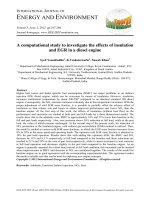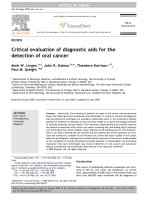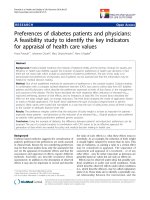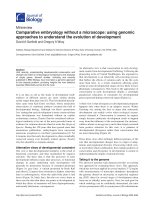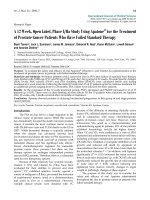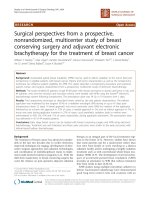DETECT I & DETECT II: A study protocol for a prospective multicentre observational study to validate the UroMark assay for the detection of bladder cancer from urinary cells
Bạn đang xem bản rút gọn của tài liệu. Xem và tải ngay bản đầy đủ của tài liệu tại đây (1012.58 KB, 7 trang )
Tan et al. BMC Cancer (2017) 17:767
DOI 10.1186/s12885-017-3758-7
STUDY PROTOCOL
Open Access
DETECT I & DETECT II: a study protocol for a
prospective multicentre observational study
to validate the UroMark assay for the
detection of bladder cancer from urinary
cells
Wei Shen Tan1,2* , Andrew Feber3, Liqin Dong3, Rachael Sarpong4, Sheida Rezaee3, Simon Rodney1,2,
Pramit Khetrapal1,2, Patricia de Winter1, Frelyn Ocampo2, Rumana Jalil4, Norman R. Williams4,
Chris Brew-Graves4 and John D. Kelly1,2
Abstract
Background: Haematuria is a common finding in general practice which requires visual inspection of the bladder
by cystoscopy as well as upper tract imaging. In addition, patients with non-muscle invasive bladder cancer (NMIBC)
often require surveillance cystoscopy as often as three monthly depending on disease risk. However, cystoscopy is an
invasive procedure which is uncomfortable, requires hospital attendance and is associated with a risk of urinary tract
infection. We have developed the UroMark assay, which can detect 150 methylation specific alteration specific to
bladder cancer using DNA from urinary sediment cells.
Methods: DETECT I and DETECT II are two multi-centre prospective observational studies designed to conduct a robust
validation of the UroMark assay. DETECT I will recruit patients having diagnostic investigations for haematuria to determine
the negative predictive value of the UroMark to rule out the presence of bladder cancer. DETECT II will recruit patients with
new or recurrent bladder cancer to determine the sensitivity of the UroMark in detecting low, intermediate and high grade
bladder cancer. NMIBC patients in DETECT II will be followed up with three monthly urine sample collection for 24 months
while having surveillance cystoscopy. DETECT II will include a qualitative analysis of semi-structured interviews to explore
patients’ experience of being diagnosed with bladder cancer and having cystoscopy and a urinary test for bladder cancer
surveillance. Results of the UroMark will be compared to cystoscopy findings and histopathological results in patients with
bladder cancer.
Discussion: A sensitive and specific urinary biomarker will revolutionise the haematuria diagnostic pathway and
surveillance strategies for NMIBC patients. None of the six approved US Food and Drug Administration urinary test are
recommended as a standalone test. The UroMark assay is based on next generation sequencing technology which
interrogates 150 loci and represents a step change compared to other biomarker panels. This enhances the sensitivity of
the test and by using a random forest classifier approach, where the UroMark results are derived from a cut off generated
from known outcomes of previous samples, addresses many shortcomings of previous assays.
(Continued on next page)
* Correspondence:
1
Division of Surgery and Interventional Science, University College London,
74 Huntley Street, London WC1E 6AU, UK
2
Department of Urology, University College London Hospitals, London, UK
Full list of author information is available at the end of the article
© The Author(s). 2017 Open Access This article is distributed under the terms of the Creative Commons Attribution 4.0
International License ( which permits unrestricted use, distribution, and
reproduction in any medium, provided you give appropriate credit to the original author(s) and the source, provide a link to
the Creative Commons license, and indicate if changes were made. The Creative Commons Public Domain Dedication waiver
( applies to the data made available in this article, unless otherwise stated.
Tan et al. BMC Cancer (2017) 17:767
Page 2 of 7
(Continued from previous page)
Trial registration: Both trails are registered on clinicaltrials.gov. DETECT I: NCT02676180 (18th December 2015). DETECT II:
NCT02781428 (11th May 2016).
Keywords: Bladder cancer, Clinical trial, Diagnostic, Haematuria, Methylation, Next generation sequencing, Urinary assay,
Urinary biomarker, Surveillance, Validation
Background
Haematuria is a common finding in general practice [1]
and requires visual inspection of the bladder by cystoscopy
as well as upper tract imaging [2]. Both non-visible and
visible haematuria are associated with the presence of
bladder cancer [3]. However, bladder cancer is responsible
for only 12.0% and 5.2% of visible and non-visible haematuria respectively [4]. Cystoscopy is an invasive procedure
which is uncomfortable, requires hospital attendance and
is associated with a 5% risk of urinary tract infection [5]. It
is estimated that using cystoscopy to investigate haematuria cost the UK healthcare £55 million per year, ranking
bladder cancer as one of the most expensive cancers to
manage [6]. Furthermore, patients with known nonmuscle invasive bladder cancer (NMIBC) will require
surveillance cystoscopy as frequently as 3 monthly in high
risk cases due to the risk of disease recurrence and progression of between 31%–78% and 17%–45% respectively
within 5 years [7]. Hence, a non-invasive urinary test
which can rule out the presence of bladder cancer would
be of great value.
Two Health Technology Assessment (HTA) commissioned systematic reviews have highlighted the clinical
need for urinary based markers for the detection of bladder cancer [8, 9]. Currently available Food and Drug Administration (FDA) approved urinary based markers
have failed to become standard practice as they miss a
significant number of patients with bladder cancer and
are subject to a high number of false positives [10].
Hence, no urinary biomarker has been approved as a
standalone test for the detection of bladder cancer and
cystoscopy is still recommended.
Epigenetic alterations such as DNA methylation make
an ideal non-invasive biomarker for the detection and
surveillance of disease given its ontogenic plasticity and
tissue specificity. A number of emerging assays based on
epigenomic panels have shown the potential utility of
DNA methylation changes as urinary biomarkers for the
detection of bladder cancer [11, 12]. We have developed
the UroMark assay, which can detect 150 methylated
specific alteration using DNA from urinary sediment
cells. Full details of the development of this assay has
been described previously [13]. Unlike previous reported
tests, the UroMark assay utilises microdroplet-based
polymerase chain reaction (PCR) application followed by
next-generation sequencing of amplification of target
loci using RainDance Technology, which allows sensitive,
specific and simultaneous amplification of up to 20,000
methylated loci [14–16]. DETECT I and DETECT II are
two multi-centre prospective observational studies designed
to conduct a robust validation of the UroMark assay.
Methods/design
Both DETECT I and DETECT II are prospective multicentre observational study designed to assess the diagnostic performance of the UroMark. Both studies will
recruit patients in >30 centres in the UK.
Detect I
Objectives
The primary objective of DETECT I is to determine the
negative predictive value of the UroMark assay to rule out
the presence of bladder cancer in patients with haematuria. The secondary objectives include 1) to assess the
feasibility of a large scale home urine collection system for
high throughput analysis, 2) exploratory health economics
analysis of patients’ views on the use of a urine based test
and 3) to assess the negative predictive value and positive
predictive value of the combination of standard of care
imaging with the UroMark in the entire cohort and in
pre-defined sub-groups of patients.
Study design
The study will recruit patients who are referred for
haematuria investigations by their general practitioner
(GP). Inclusion criteria include 1) patients ≥18 years of
age, 2) undergoing cystoscopy for visible or non-visible
haematuria, 3) had upper tract imaging (either ultrasound kidney, ureters and bladder (KUB), CT KUB or
CT intravenous urogram (IVU)) within 12 weeks of
registration into the study and 4) patients who are able
to provide informed consent. Patients who are unwilling
to have cystoscopy and upper tract imaging or unable to
give informed consent will be excluded.
The study schedule for DETECT I is reported in Fig. 1.
Written informed consent will be obtained and patients
will be screened for eligibility and inclusion into the
trial. Patients will be given a UroMark home urine collection kit and samples are mailed to the laboratory in a
prepaid postage envelope in packaging specifically
designed for this purpose, and approved by Royal Mail.
Patients will have standard haematuria investigations
Tan et al. BMC Cancer (2017) 17:767
Page 3 of 7
Fig. 1 Study schedule for DETECT I
It is expected that 90% of all tests would be negative
thus; we will require at least 889 evaluable urine
samples. With this sample size, the uncertainty in the estimated NPV will be less than 1% if the NPV is higher
than 98%. The data analysis will involve calculating the
NPV from the data, along with an exact binomial confidence interval. To ensure confidence subjects will be recruited until at least 89 tumours have been detected. It
is proposed that the NPV will be examined after a third
of cases have been recruited (approximately 300 cases).
If the NPV is substantially below that assumed, the study
may be terminated early.
For the secondary outcome, the NPV of imaging
(ultrasound KUB/CT) alone and the combination of
imaging and the UroMark assay will be determined. Specifically, the NPV of UroMark will be calculated for the
following subgroups: haematuria type (visible vs nonvisible), gender (male vs female), age (≤50 vs >50 years)
and smoking history (yes vs no). Fisher’s exact test will
be used to determine the NPV.
which consist of flexible cystoscopy and upper tract imaging. They will also be asked to complete a health economics questionnaire which is designed to capture their
opinion and perspectives on their confidence in having a
specialised assay to diagnose their bladder cancer instead
of cystoscopy. Patients with cystoscopic evidence of
tumour will be treated with transurethral resection of
bladder tumour (TURBT) as part of standard practice
and histopathological evidence of tumour will be used a
standard reference. All urine samples are collected prior
to TURBT.
The study protocol was approved by Health Research
Authority: North West Liverpool Central Research Ethics Committee on the 9 th March 2016 (IRAS project ID:
179,245, REC reference: 16/NW/0150). DETECT I is
registered on clinicaltrials.gov NCT02676180.
Assessment
Patient demographics including age, gender, occupation,
ethnicity and smoking history will be recorded. Results
of flexible cystoscopy, upper tract and bladder imaging
and histopathological results (if TURBT or bladder biopsy is performed) will be recorded in an electronic case
report form (eCRF).
Sample size and power calculations
The primary outcome of DETECT I is the negative
predicted value (NPV) of the UroMark assay which is
expected to be 98% (or higher). Using the exact binomial
method, to give a lower bound for a 95% confidence
interval of 96.75%, 800 negative test results are required.
DETECT II
Objectives
The primary objective of DETECT II is to determine the
sensitivity of the UroMark to detect new and recurrent
low, intermediate and high grade bladder cancer.
Secondary objectives include 1) to determine whether
the UroMark can detect NMIBC recurrence in patients
undergoing cystoscopic surveillance for bladder cancer,
2) to assess patients’ perspectives on cystoscopy and
using a non-invasive urinary test and 3) to use semistructured patient interviews to qualitatively explore patients experience of being diagnosed with bladder cancer
and having cystoscopy and a non-invasive urinary test as
a method of bladder cancer surveillance.
Study design
The study will recruit patients with new or recurrent
bladder cancer. Patients who are not willing to have
TURBT or unable to give consent will be excluded.
The DETECT II study schedule is reported in Fig. 2. Patients will be screened and included into the trial at flexible
cystoscopy after visual confirmation of new or recurrent
bladder tumour. Written consent will then be obtained
from eligible patients. A baseline urine sample will be collected using the same home urine collection kit being used
in DETECT I. Urine collection must be performed prior to
TURBT. Histopathological confirmation of tumour stage
(Ta, T1, ≥T2) and grade (G1, G2, G3) with or without CIS,
or isolated CIS will be used a reference standard.
All patients will receive standard test and investigations
for bladder cancer. Following a TURBT, it is recommended that patients with NMIBC will receive a single instillation of intravesical chemotherapy unless clinically
Tan et al. BMC Cancer (2017) 17:767
Page 4 of 7
Fig. 2 Study Schedule DETECT II
contraindicated. Intermediate risk NMIBC will have an inductive course of intravesical chemotherapy post TURBT
while high risk NMIBC may require a repeat TURBT, usually within 6 weeks of the first TURBT. The repeat resection is recommended for high risk tumours to exclude
residual detrusor muscle invasion (pT2 at least). High risk
patients will either have an inductive and maintenance
course of intravesical BCG or a radical cystectomy. This is
consistent with international consensus [17].
Patients with NMIBC will have periodic cystoscopic
surveillance following TURBT between 3 to 12 month
intervals depending on disease risk in accordance to
local hospital guidelines. Patients will be asked to provide a urine sample using a UroMark urinary collection
kit every 3 months for 24 months (Table 1). It is important that urine samples are collected prior to TURBT to
capture urine positive for recurrent tumour.
NMIBC patients undergoing surveillance will complete
a questionnaire designed to assess their perspectives on
cystoscopy compared with a urinary test as part of
surveillance to detect bladder cancer recurrence
(Table 1). Selected patients will be invited for a telephone interview to further explore their experience of
being diagnosed with bladder cancer and having cystoscopy and a urinary test as a method of bladder
cancer surveillance. Up to 40 patients will participate
in a qualitative analysis of semi-structured interviews
but this number may be lower if patient responses
have reached a saturation point. Patients will be interviewed after a minimum of 6 months’ follow-up to
ensure all patients will be able to provide an informed opinion after having both diagnostic investigations: cystoscopy and urine based test.
DETECT II study protocol received Health Research
Authority: London- Stanmore Research Ethics Committee approval on the 30th August 2016 (IRAS project ID:
203,022, REC reference: 16/LO/1044). This trial is registered on clinicaltrials.gov NCT02781428.
Tan et al. BMC Cancer (2017) 17:767
Page 5 of 7
Table 1 Table of Assessments in DETECT II
Visit
Baseline
Before TURBT
Inclusion criteria
X
Smoking history
X
Visual Diagnosis of bladder cancer
X
3 Month
6 Month
9 Month
12 Month
15 Month
18 Month
21 Month
24 Month
Surveillance Cystoscopy:
Low risk
X
X
Intermediate risk
X
High risk
X
X
X
X
X
X
X
X
X
X
X
X
X
X
X
X
UroMark Test
X
X
Assessment
Patient demographics including age, and smoking history will be recorded as well as cystoscopy and TURBT
or bladder biopsy histopathology results. Any adjuvant
treatment post endoscopic management will also be recorded. Registration of patients and recording of all data
is done electronically. However, results of the UroMark
will not be reported to the treating clinicians to ensure
there is no deviation from standard of care. Results of
each surveillance cystoscopy will be recorded and any
subsequent management. All results will be recorded in
an online eCRF.
Sample size and power calculations
The primary aim of DETECT II is to determine the sensitivity of the UroMark assay in detecting Grade 1, 2 and
3 bladder cancers. It is proposed that at least 380 urine
samples will be required from bladder cancer patients.
This sample size is based on the assumption of 95% sensitivity and a 95% confidence interval ranging between
92.3% and 97.0%. It is essential to test the ability of the
UroMark assay to detect low grade bladder cancer and
these cancers will represent at least 15%–20% of disease
detected. In order to reduce the uncertainty in estimating sensitivity, we aim to enrich the cases recruited with
at least 100 cases from other clinical trials (including 60
with low grade disease). It is estimated that the sensitivity for detection of these cancers will be 80% which will
provide a 95% CI of between 70.8% to 87.3%.
Discussion
There are six FDA approved urinary biomarkers which
are available commercially for clinical use. These are:
BTA stat (Polymedco), BTA TRAK (Polymedco),
NMP22 BC test kit (Matritech), NMP22 BladderCheck
Test (Alere), ImmunoCyt (Scimedx) and UroVysion
Bladder Cancer Kit (Abbott Molecular). These biomarkers have a sensitivity between 57 and 82% and a
specificity of 74–88% [10] and in all tests, the sensitivity
was higher in high grade and stage tumours. Bladder
X
cancer is a heterogeneous disease and an inherent flaw
of currently available commercial assays are the reliance
on single or small panel of markers, and none are licensed to be used without cystoscopy [18]. For example,
the UroVysion uses 5 genomic probes and NMP22 Bladdercheck detects a single protein.
Studies on methylation specific markers have reported
a sensitivity of between 65 and 100% and specificity of
77–100% [19]. The majority of these studies use methylation specific PCR to profile only a few genes (between
one to six) due to the limited amount of DNA which
can be extracted from urinary sediment [20]. However,
none of these novel assays have been regulatory approved. Given that bladder cancer is a heterogenous disease, it is possible that more genes would be necessary
to detect the presence of bladder cancer from urinary
DNA [21].
The UroMark assay is novel in concept and designed
to interrogate 150 methylation specific loci which will
enhance test sensitivity. The number of markers used
previously has been limited by the amount of DNA from
urinary cell pellet. However, using RainDance Microdroplet PCR as previously described, this limitation has
been overcome [14, 15]. In addition, the UroMark assay
uses a random forest classifier which analyses the
methylation status for each of 150 loci [22]. The classifier does not rely on single or low number of positive
markers, or, a predefined pattern of methylation across a
set of markers and a dichotomous output is derived
from a cut off generated from the known outcomes of
prior samples. To our knowledge this the first approach
using high throughput sequencing technology for the
development of a bladder cancer detection assay and it
addresses many of the shortcomings of previously
assays.
Most studies reported previously were retrospective
studies comparing results of a urinary biomarker in a
cohort of bladder cancer patients with controls. In
DETECT I, all patients recruited are referred by their
GP for haematuria evaluation. These patients are
Tan et al. BMC Cancer (2017) 17:767
typically investigated by cystoscopic evaluation of the
bladder and an upper tract scan within two weeks in
dedicated haematuria clinics in urology departments
throughout the UK. It is estimated that there are over
100,000 haematuria referrals by GPs in the UK [23].
Similar to DETECT I, recruitment into DETECT II
should be achievable given there are >12,000 new
bladder cancer cases per year in England and Wales
[24]. Furthermore, using prospectively collected urine
samples from bladder cancer trials in low and intermediate risk bladder cancer patients will allow us to
enrich for this group of patients which has proved
challenging for other non-invasive urine tests.
DETECT I will also test the feasibility of changing
the haematuria diagnostic pathway from one which
requires a hospital visit to a system where potentially
GPs can request a bladder cancer diagnostic investigations without the need for the patient to attend a
hospital clinic. DETECT II will provide data to determine if periodic urine testing of NMIBC patients for
DNA methylation changes to interrogate recurrence
would be as effective as cystoscopy. This is a novel
approach, and a convenient and cost-effective alternative. Reporting of patients’ views of using a urine
based test compared to cystoscopy has been limited
[25, 26]. A qualitative analysis of semi-structured interviews in a cohort of NMIBC patients having both
surveillance cystoscopy and using a urinary test will
allow an assessment of patients’ views and interrogate
the complexities and subtleties of their decision making process which has not been performed previously.
Conclusion
DETECT I and II is a multi-centre prospective observational studies designed to conduct a robust validation of the UroMark assay. DETECT I will validate
the ability of the UroMark assay to rule out bladder
cancer in patients with haematuria while DETECT II
will determine the diagnostic accuracy of the assay in
a patient cohort enriched for low grade cancer and
test the ability of the UroMark assay to detect bladder cancer recurrence. We aim to show sufficient
diagnostic precision to replace cystoscopy in the
evaluation of patients with haematuria. The incorporation of a highly sensitive and specific assay will revolutionise bladder cancer pathways, have a profound
impact on the requirement for cystoscopy and on patient well-being and, reduce the healthcare costs associated with investigation of haematuria and
surveillance for disease recurrence.
Trial status
DETECT I commenced recruitment on the 30th March
2016 and anticipated to close on 1st Feb 2019. DETECT
Page 6 of 7
I was approved by the Health Research Authority: North
West Liverpool Central Research Ethics Committee on
the 9th March 2016. DETECT II commenced recruitment on the 26th September 2016 and will likely close
on 25th September 2019. DETECT II was approved by
the Health Research Authority: London Stanmore Research Ethics Committee on the 30th August 2016. Both
trials are currently recruiting patients and are registered
on clinicaltrials.gov.
Abbreviations
BTA: Bladder tumour antigen; CT KUB: Computer tomography of the kidneys,
ureters and bladder; DNA: Deoxyribonucleic acid; eCRF: electronic case
report form; FDA: Food and Drug Administration; FISH: Fluorescence in situ
hybridization; HTA: health technology assessment; IVU: Intravenous urogram;
KUB: Kidney, ureters and bladder; NMIBC: non-muscle invasive bladder
cancer; NMP22: nuclear matrix protein 22; NPV: Negative predictive value;
PCR: polymerase chain reaction; TURBT: Transurethral resection of bladder
tumour
Acknowledgements
This project is funded by the Medical Research Council [grant number Kelly
MR/M025411/1] and the UCL/UCLH Biomedical Research Committee. The
Urology Foundation contributed towards the salary of the research fellow of
the trial. We are grateful for the UCL Surgical & Interventional Trials Unit
(SITU) for co-ordinating the trial.
Funding
The research cost for DETECT I and DETECT II will be supported by the
Medical Research Council [grant number Kelly MR/M025411/1]. NHS cost will
be supported by UCLH and/ or the Local Clinical Research Network. All
funding bodies have no role in the design of the study and collection,
analysis, and interpretation of data and in writing the manuscript.
Availability of data and materials
Not applicable.
Authors’ contributions
Study concept and initial design: JDK, AF, WST, NW, CBG. Study design and
statistical analysis: JDK, AF, WST, NW, CBG. Acquisition of data and Data
analysis and interpretation: AF, WST, LD, RS, SRe, SRo, PK, PDW, FO, RJ, NW,
CBG, JDK. All authors read and approved the final manuscript.
Ethics approval and consent to participate
DETECT I was approved by NHS Health Research Authority on the 18th May
2016 (IRAS project ID: 179,245, REC reference: 16/NW/0150, clinicaltrials.gov:
NCT02676180). DETECT II study protocol received NHS Health Research
Authority approval on the 30th August 2016 (IRAS project ID: 203,022, REC
reference: 16/LO/1044, clinicaltrials.gov: NCT02781428). Written consent will
be obtained from all patients.
Consent for publication
Not applicable.
Competing interests
The authors declare that they have no competing interests.
Publisher’s Note
Springer Nature remains neutral with regard to jurisdictional claims in
published maps and institutional affiliations.
Author details
1
Division of Surgery and Interventional Science, University College London,
74 Huntley Street, London WC1E 6AU, UK. 2Department of Urology,
University College London Hospitals, London, UK. 3UCL Cancer Institute,
University College London, London, UK. 4Surgical & Interventional Trials Unit,
Division of Surgery and Interventional Sciences, Faculty of Medical Sciences,
University College London, London, UK.
Tan et al. BMC Cancer (2017) 17:767
Received: 8 January 2017 Accepted: 6 November 2017
References
1. Mohr DN, Offord KP, Owen RA. Melton LJ, 3rd: Asymptomatic
microhematuria and urologic disease. A population-based study. JAMA.
1986;256(2):224–9.
2. Nielsen M, Qaseem A. Hematuria as a marker of occult urinary tract cancer:
advice for high-value care from the American College of Physicians. Ann
Intern Med. 2016;164(7):488–97.
3. Price SJ, Shephard EA, Stapley SA, Barraclough K, Hamilton WT. Non-visible
versus visible haematuria and bladder cancer risk: a study of electronic
records in primary care. Br J Gen Pract. 2014;64(626)
4. Khadra M, Pickard R, Charlton M, Powell P, Neal D. A prospective analysis of
1,930 patients with hematuria to evaluate current diagnostic practice. J Urol.
2000;163(2):524–7.
5. Burke DM, Shackley DC, O'Reilly PH. The community-based morbidity of
flexible cystoscopy. BJU Int. 2002;89(4):347–9.
6. Sangar VK, Ragavan N, Matanhelia SS, Watson MW, Blades RA. The
economic consequences of prostate and bladder cancer in the UK. BJU Int.
2005;95(1):59–63.
7. Sylvester RJ, van der Meijden AP, Oosterlinck W, Witjes JA, Bouffioux C,
Denis L, Newling DW, Kurth K: Predicting recurrence and progression in
individual patients with stage ta T1 bladder cancer using EORTC risk tables:
a combined analysis of 2596 patients from seven EORTC trials. Eur Urol
2006, 49(3):466–477.
8. Rodgers M, Nixon J, Hempel S, Aho T, Kelly J, Neal D, Duffy S, Ritchie G,
Kleijnen J, Westwood M. Diagnostic tests and algorithms used in the
investigation of haematuria: systematic reviews and economic evaluation.
Health Technol Assess. 2006;10(18):xi–259.
9. Mowatt G, N'Dow J, Vale L, Nabi G, Boachie C, Cook JA, Fraser C, Griffiths TR.
Photodynamic diagnosis of bladder cancer compared with white light
cystoscopy: systematic review and meta-analysis. Int J Technol Assess
Health Care. 2011;27(1):3–10.
10. Chou R, Gore JL, Buckley D, Fu R, Gustafson K, Griffin JC, Grusing S, Selph S.
Urinary biomarkers for diagnosis of bladder cancer: a systematic review and
meta-analysis. Ann Intern Med. 2015;163(12):922–31.
11. Kandimalla R, Masius R, Beukers W, Bangma CH, Orntoft TF, Dyrskjot L, van
Leeuwen N, Lingsma H, van Tilborg AA, Zwarthoff EC. A 3-plex methylation
assay combined with the FGFR3 mutation assay sensitively detects recurrent
bladder cancer in voided urine. Clin Cancer Res. 2013;19(17):4760–9.
12. Kelly JD, Dudderidge TJ, Wollenschlaeger A, Okoturo O, Burling K, Tulloch F,
Halsall I, Prevost T, Prevost AT, Vasconcelos JC, et al. Bladder cancer
diagnosis and identification of clinically significant disease by combined
urinary detection of Mcm5 and nuclear matrix protein 22. PLoS One.
2012;7(7):e40305.
13. Feber A, Dhami P, Dong L, de Winter P, Tan WS, Martínez-Fernández M,
Paul DS, Hynes-Allen A, Rezaee S, Gurung P. UroMark—a urinary biomarker
assay for the detection of bladder cancer. Clin Epigenetics. 2017;9(1):8.
14. Paul DS, Guilhamon P, Karpathakis A, Butcher LM, Thirlwell C, Feber A, Beck
S. Assessment of RainDrop BS-seq as a method for large-scale, targeted
bisulfite sequencing. Epigenetics. 2014;9(5):678–84.
15. Guilhamon P, Eskandarpour M, Halai D, Wilson GA, Feber A, Teschendorff
AE, Gomez V, Hergovich A, Tirabosco R, Fernanda Amary M, et al. Metaanalysis of IDH-mutant cancers identifies EBF1 as an interaction partner for
TET2. Nat Commun. 2013;4:2166.
16. Komori HK, LaMere SA, Torkamani A, Hart GT, Kotsopoulos S, Warner J,
Samuels ML, Olson J, Head SR, Ordoukhanian P, et al. Application of
microdroplet PCR for large-scale targeted bisulfite sequencing. Genome Res.
2011;21(10):1738–45.
17. Tan WS, Rodney S, Lamb B, Feneley M, Kelly J. Management of non-muscle
invasive bladder cancer: a comprehensive analysis of guidelines from the
United States, Europe and Asia. Cancer Treat Rev. 2016;47:22–31.
18. Mowatt G, Zhu S, Kilonzo M, Boachie C, Fraser C, Griffiths TR, N'Dow J, Nabi
G, Cook J, Vale L. Systematic review of the clinical effectiveness and costeffectiveness of photodynamic diagnosis and urine biomarkers (FISH,
ImmunoCyt, NMP22) and cytology for the detection and follow-up of
bladder cancer. Health Technol Assess. 2010;14(4):1–331. iii-iv
19. Mbeutcha A, Lucca I, Mathieu R, Lotan Y, Shariat SF. Current status of
urinary biomarkers for detection and surveillance of bladder cancer. Urol
Clin N Am. 2016;43(1):47–62.
Page 7 of 7
20. Dahmcke CM, Steven KE, Larsen LK, Poulsen AL, Abdul-Al A, Dahl C,
Guldberg P. A prospective blinded evaluation of urine-DNA testing for
detection of urothelial bladder carcinoma in patients with gross hematuria.
Eur Urol. 2016;70(6):916–9.
21. Presti JC, Jr., Reuter VE, Galan T, Fair WR, Cordon-Cardo C: Molecular genetic
alterations in superficial and locally advanced human bladder cancer.
Cancer Res 1991, 51(19):5405–5409.
22. Moorthy K, Mohamad MS. Random forest for gene selection and microarray
data classification. Bioinformation. 2011;7(3):142–6.
23. Cancer Research UK. Bladder Cancer. [ />about-cancer/type/bladder-cancer/].
24. Cancer Research UK. Bladder Cancer Incidence Statistics 2016. http://www.
cancerresearchuk.org/health-professional/cancer-statistics/statistics-bycancer-type/bladder-cancer/incidence.
25. Vriesema JL, Poucki MH, Kiemeney LA, Witjes JA. Patient opinion of urinary
tests versus flexible urethrocystoscopy in follow-up examination for
superficial bladder cancer: a utility analysis. Urology. 2000;56(5):793–7.
26. Yossepowitch O, Herr HW, Donat SM. Use of urinary biomarkers for bladder
cancer surveillance: patient perspectives. J Urol. 2007;177(4):1277–82.
Submit your next manuscript to BioMed Central
and we will help you at every step:
• We accept pre-submission inquiries
• Our selector tool helps you to find the most relevant journal
• We provide round the clock customer support
• Convenient online submission
• Thorough peer review
• Inclusion in PubMed and all major indexing services
• Maximum visibility for your research
Submit your manuscript at
www.biomedcentral.com/submit

